The Transformation of the Vietnam Market: A Comprehensive Analysis
VerifiedAdded on 2022/11/01
|12
|3182
|218
Report
AI Summary
This report provides a comprehensive analysis of the transformation of the Vietnam market, covering its historical background from ancient times to recent developments, including the impact of the Doi Moi reforms. It delves into the political scenario, describing the country's communist system, the role of the government, and its implications for businesses, including foreign relations and political influences. The report examines the economic institutions, including the banking sector, trade, and investment policies, highlighting key economic indicators such as GDP, growth rates, and the role of the State Bank of Vietnam. It also discusses the judicial system and its impact on business operations. Overall, the report offers a detailed overview of Vietnam as a market for international business, including its strengths, challenges, and future prospects. The report also details the demographics of the country, including ethnic groups, religion, education level, and major industries, exports, imports, and trading partners.
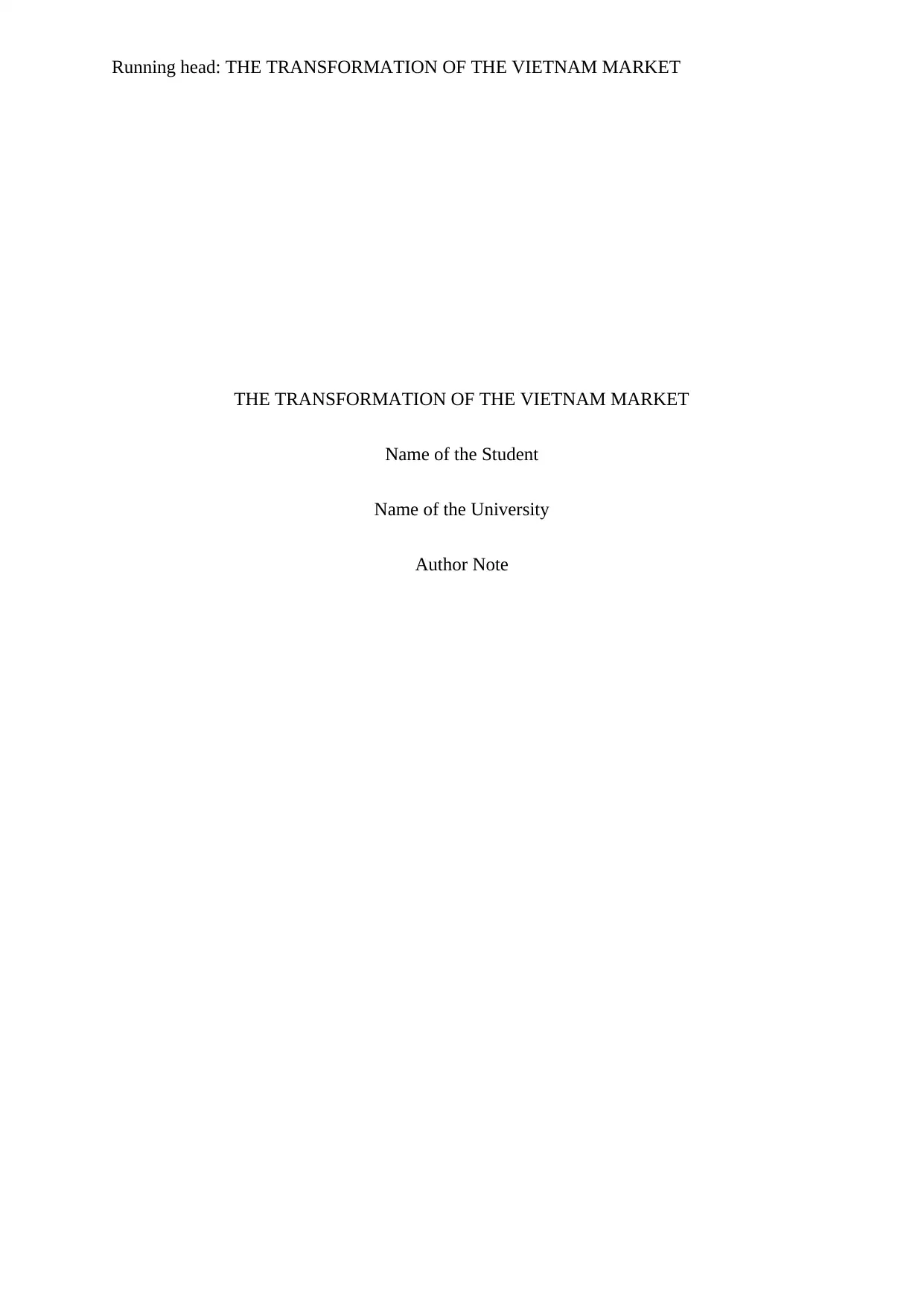
Running head: THE TRANSFORMATION OF THE VIETNAM MARKET
THE TRANSFORMATION OF THE VIETNAM MARKET
Name of the Student
Name of the University
Author Note
THE TRANSFORMATION OF THE VIETNAM MARKET
Name of the Student
Name of the University
Author Note
Paraphrase This Document
Need a fresh take? Get an instant paraphrase of this document with our AI Paraphraser
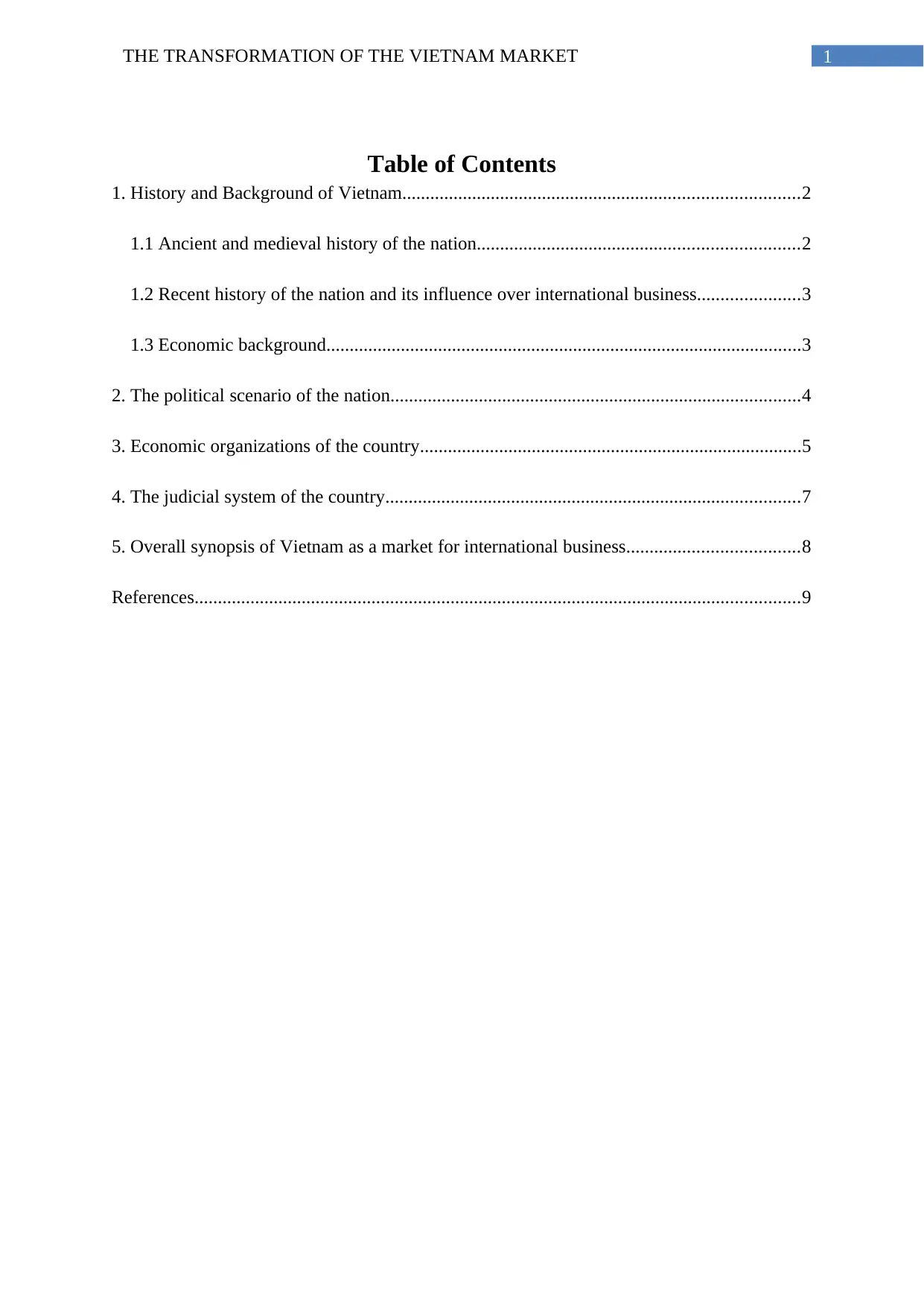
1THE TRANSFORMATION OF THE VIETNAM MARKET
Table of Contents
1. History and Background of Vietnam.....................................................................................2
1.1 Ancient and medieval history of the nation.....................................................................2
1.2 Recent history of the nation and its influence over international business......................3
1.3 Economic background......................................................................................................3
2. The political scenario of the nation........................................................................................4
3. Economic organizations of the country..................................................................................5
4. The judicial system of the country.........................................................................................7
5. Overall synopsis of Vietnam as a market for international business.....................................8
References..................................................................................................................................9
Table of Contents
1. History and Background of Vietnam.....................................................................................2
1.1 Ancient and medieval history of the nation.....................................................................2
1.2 Recent history of the nation and its influence over international business......................3
1.3 Economic background......................................................................................................3
2. The political scenario of the nation........................................................................................4
3. Economic organizations of the country..................................................................................5
4. The judicial system of the country.........................................................................................7
5. Overall synopsis of Vietnam as a market for international business.....................................8
References..................................................................................................................................9
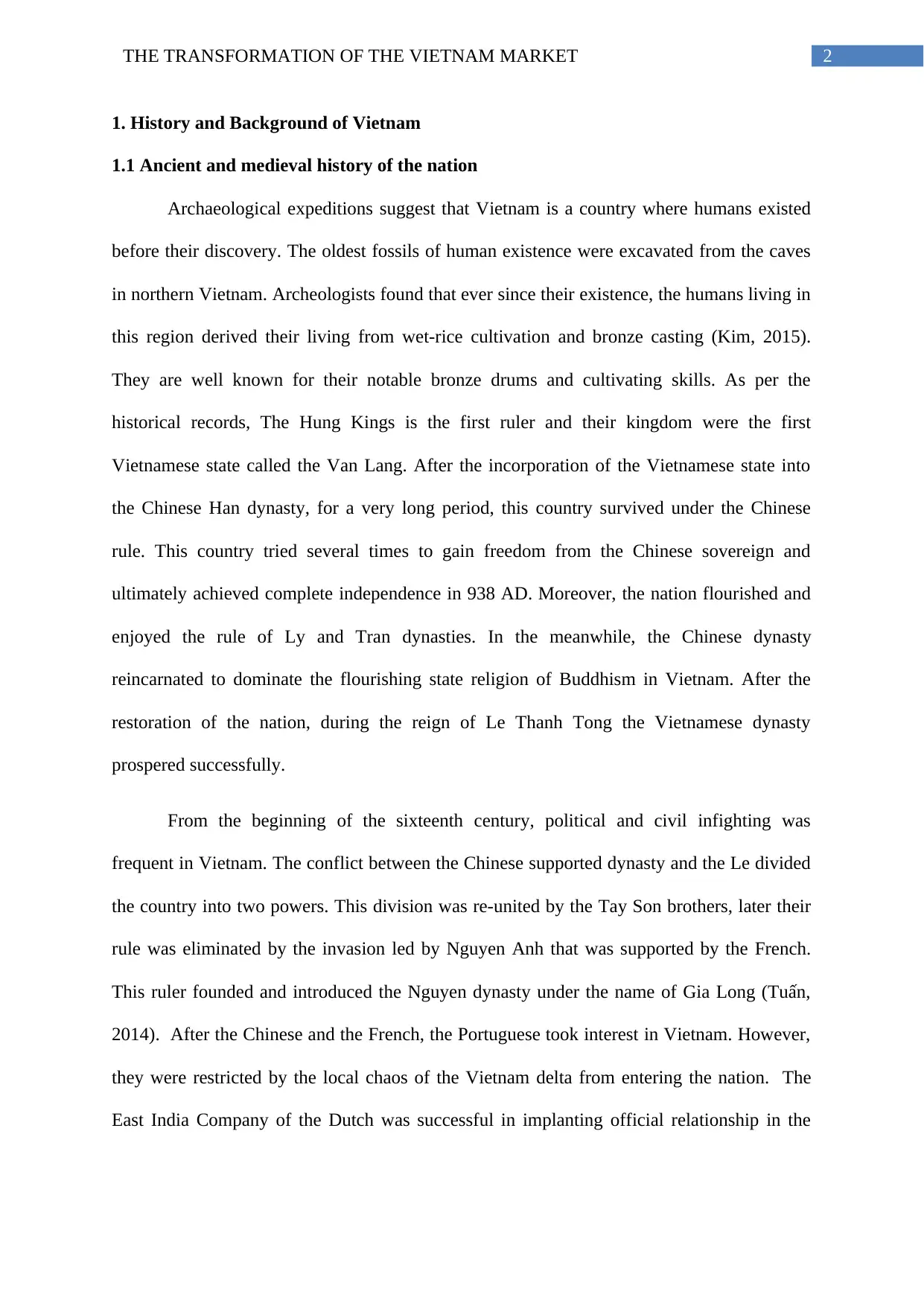
2THE TRANSFORMATION OF THE VIETNAM MARKET
1. History and Background of Vietnam
1.1 Ancient and medieval history of the nation
Archaeological expeditions suggest that Vietnam is a country where humans existed
before their discovery. The oldest fossils of human existence were excavated from the caves
in northern Vietnam. Archeologists found that ever since their existence, the humans living in
this region derived their living from wet-rice cultivation and bronze casting (Kim, 2015).
They are well known for their notable bronze drums and cultivating skills. As per the
historical records, The Hung Kings is the first ruler and their kingdom were the first
Vietnamese state called the Van Lang. After the incorporation of the Vietnamese state into
the Chinese Han dynasty, for a very long period, this country survived under the Chinese
rule. This country tried several times to gain freedom from the Chinese sovereign and
ultimately achieved complete independence in 938 AD. Moreover, the nation flourished and
enjoyed the rule of Ly and Tran dynasties. In the meanwhile, the Chinese dynasty
reincarnated to dominate the flourishing state religion of Buddhism in Vietnam. After the
restoration of the nation, during the reign of Le Thanh Tong the Vietnamese dynasty
prospered successfully.
From the beginning of the sixteenth century, political and civil infighting was
frequent in Vietnam. The conflict between the Chinese supported dynasty and the Le divided
the country into two powers. This division was re-united by the Tay Son brothers, later their
rule was eliminated by the invasion led by Nguyen Anh that was supported by the French.
This ruler founded and introduced the Nguyen dynasty under the name of Gia Long (Tuấn,
2014). After the Chinese and the French, the Portuguese took interest in Vietnam. However,
they were restricted by the local chaos of the Vietnam delta from entering the nation. The
East India Company of the Dutch was successful in implanting official relationship in the
1. History and Background of Vietnam
1.1 Ancient and medieval history of the nation
Archaeological expeditions suggest that Vietnam is a country where humans existed
before their discovery. The oldest fossils of human existence were excavated from the caves
in northern Vietnam. Archeologists found that ever since their existence, the humans living in
this region derived their living from wet-rice cultivation and bronze casting (Kim, 2015).
They are well known for their notable bronze drums and cultivating skills. As per the
historical records, The Hung Kings is the first ruler and their kingdom were the first
Vietnamese state called the Van Lang. After the incorporation of the Vietnamese state into
the Chinese Han dynasty, for a very long period, this country survived under the Chinese
rule. This country tried several times to gain freedom from the Chinese sovereign and
ultimately achieved complete independence in 938 AD. Moreover, the nation flourished and
enjoyed the rule of Ly and Tran dynasties. In the meanwhile, the Chinese dynasty
reincarnated to dominate the flourishing state religion of Buddhism in Vietnam. After the
restoration of the nation, during the reign of Le Thanh Tong the Vietnamese dynasty
prospered successfully.
From the beginning of the sixteenth century, political and civil infighting was
frequent in Vietnam. The conflict between the Chinese supported dynasty and the Le divided
the country into two powers. This division was re-united by the Tay Son brothers, later their
rule was eliminated by the invasion led by Nguyen Anh that was supported by the French.
This ruler founded and introduced the Nguyen dynasty under the name of Gia Long (Tuấn,
2014). After the Chinese and the French, the Portuguese took interest in Vietnam. However,
they were restricted by the local chaos of the Vietnam delta from entering the nation. The
East India Company of the Dutch was successful in implanting official relationship in the
⊘ This is a preview!⊘
Do you want full access?
Subscribe today to unlock all pages.

Trusted by 1+ million students worldwide
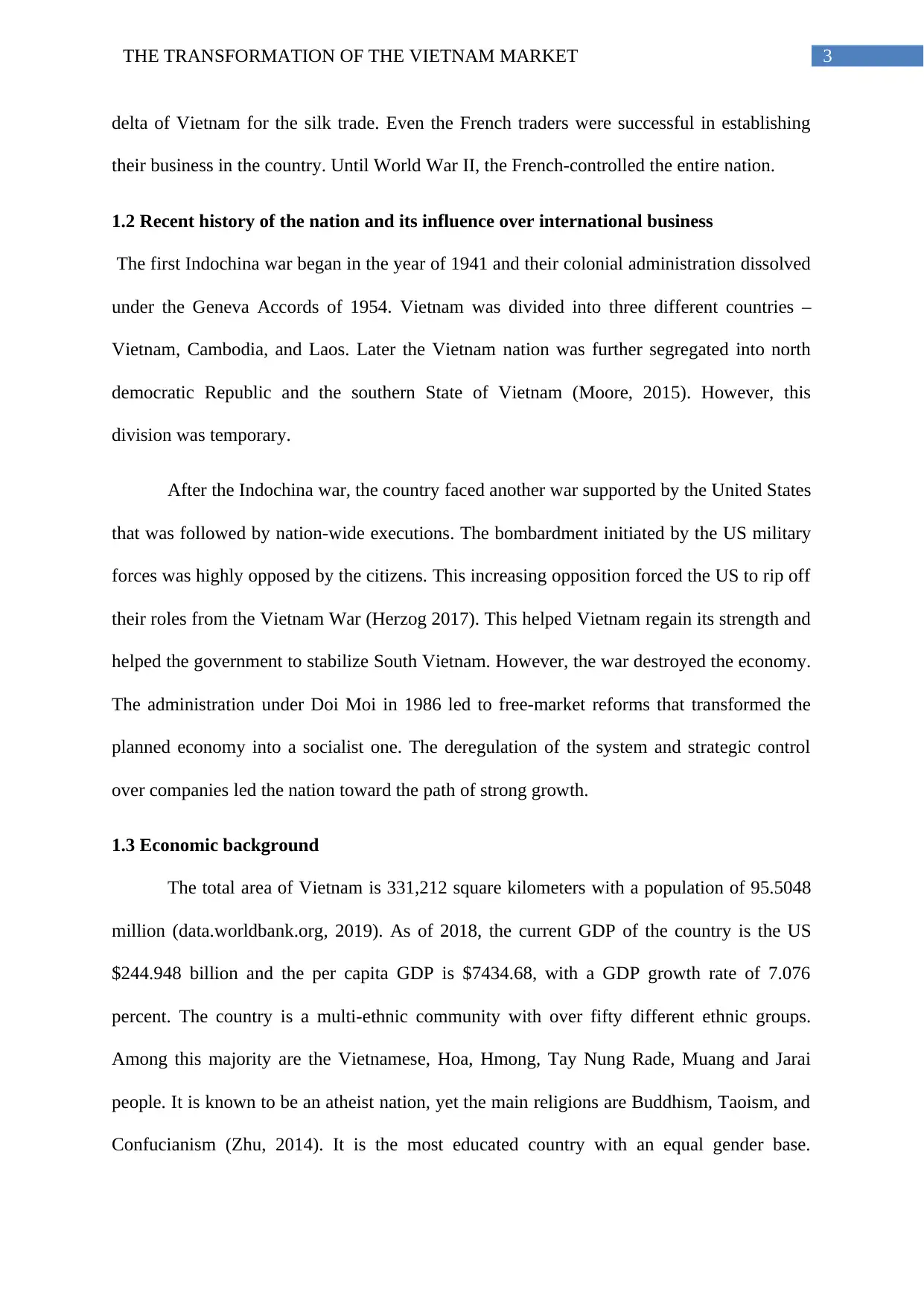
3THE TRANSFORMATION OF THE VIETNAM MARKET
delta of Vietnam for the silk trade. Even the French traders were successful in establishing
their business in the country. Until World War II, the French-controlled the entire nation.
1.2 Recent history of the nation and its influence over international business
The first Indochina war began in the year of 1941 and their colonial administration dissolved
under the Geneva Accords of 1954. Vietnam was divided into three different countries –
Vietnam, Cambodia, and Laos. Later the Vietnam nation was further segregated into north
democratic Republic and the southern State of Vietnam (Moore, 2015). However, this
division was temporary.
After the Indochina war, the country faced another war supported by the United States
that was followed by nation-wide executions. The bombardment initiated by the US military
forces was highly opposed by the citizens. This increasing opposition forced the US to rip off
their roles from the Vietnam War (Herzog 2017). This helped Vietnam regain its strength and
helped the government to stabilize South Vietnam. However, the war destroyed the economy.
The administration under Doi Moi in 1986 led to free-market reforms that transformed the
planned economy into a socialist one. The deregulation of the system and strategic control
over companies led the nation toward the path of strong growth.
1.3 Economic background
The total area of Vietnam is 331,212 square kilometers with a population of 95.5048
million (data.worldbank.org, 2019). As of 2018, the current GDP of the country is the US
$244.948 billion and the per capita GDP is $7434.68, with a GDP growth rate of 7.076
percent. The country is a multi-ethnic community with over fifty different ethnic groups.
Among this majority are the Vietnamese, Hoa, Hmong, Tay Nung Rade, Muang and Jarai
people. It is known to be an atheist nation, yet the main religions are Buddhism, Taoism, and
Confucianism (Zhu, 2014). It is the most educated country with an equal gender base.
delta of Vietnam for the silk trade. Even the French traders were successful in establishing
their business in the country. Until World War II, the French-controlled the entire nation.
1.2 Recent history of the nation and its influence over international business
The first Indochina war began in the year of 1941 and their colonial administration dissolved
under the Geneva Accords of 1954. Vietnam was divided into three different countries –
Vietnam, Cambodia, and Laos. Later the Vietnam nation was further segregated into north
democratic Republic and the southern State of Vietnam (Moore, 2015). However, this
division was temporary.
After the Indochina war, the country faced another war supported by the United States
that was followed by nation-wide executions. The bombardment initiated by the US military
forces was highly opposed by the citizens. This increasing opposition forced the US to rip off
their roles from the Vietnam War (Herzog 2017). This helped Vietnam regain its strength and
helped the government to stabilize South Vietnam. However, the war destroyed the economy.
The administration under Doi Moi in 1986 led to free-market reforms that transformed the
planned economy into a socialist one. The deregulation of the system and strategic control
over companies led the nation toward the path of strong growth.
1.3 Economic background
The total area of Vietnam is 331,212 square kilometers with a population of 95.5048
million (data.worldbank.org, 2019). As of 2018, the current GDP of the country is the US
$244.948 billion and the per capita GDP is $7434.68, with a GDP growth rate of 7.076
percent. The country is a multi-ethnic community with over fifty different ethnic groups.
Among this majority are the Vietnamese, Hoa, Hmong, Tay Nung Rade, Muang and Jarai
people. It is known to be an atheist nation, yet the main religions are Buddhism, Taoism, and
Confucianism (Zhu, 2014). It is the most educated country with an equal gender base.
Paraphrase This Document
Need a fresh take? Get an instant paraphrase of this document with our AI Paraphraser
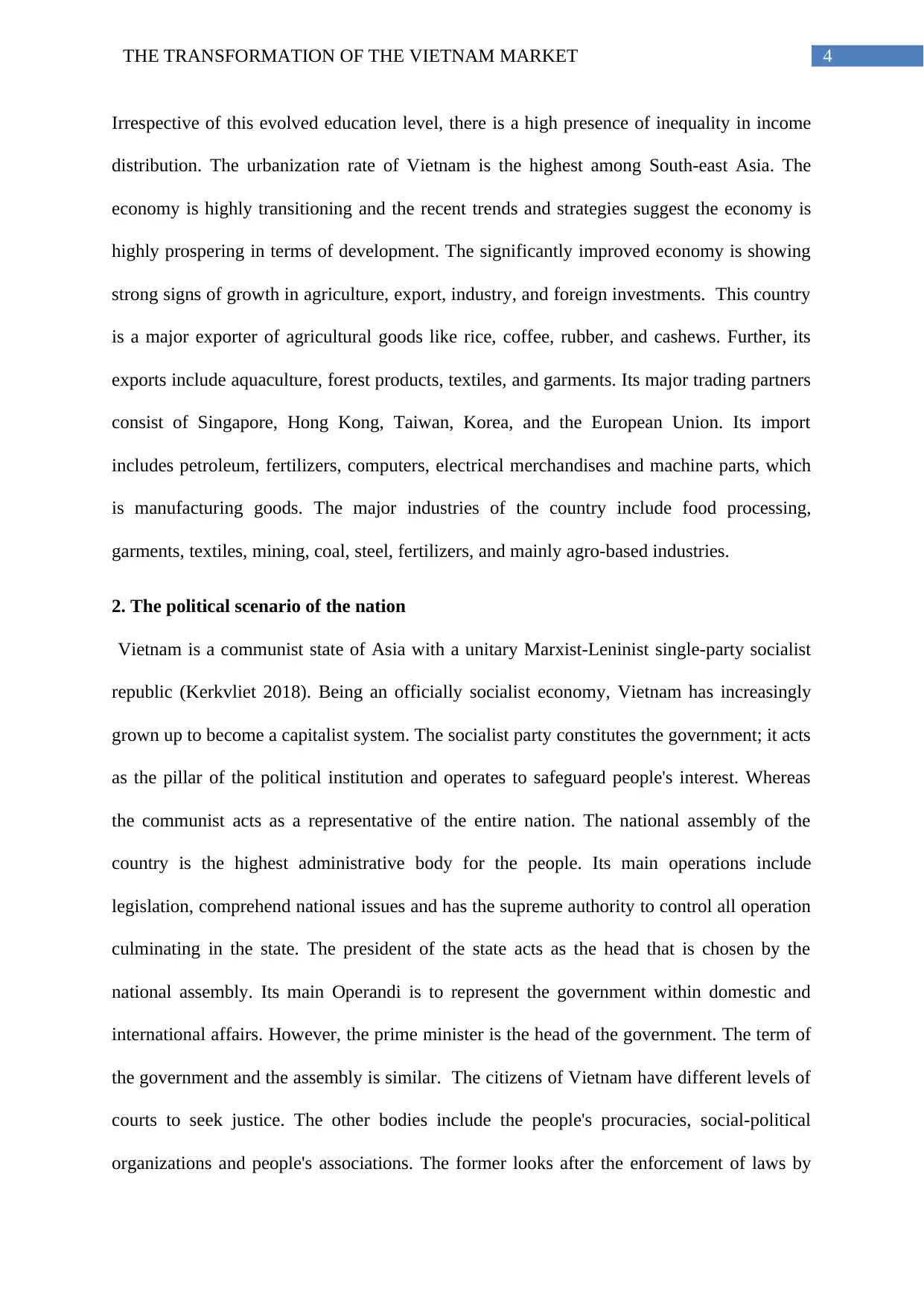
4THE TRANSFORMATION OF THE VIETNAM MARKET
Irrespective of this evolved education level, there is a high presence of inequality in income
distribution. The urbanization rate of Vietnam is the highest among South-east Asia. The
economy is highly transitioning and the recent trends and strategies suggest the economy is
highly prospering in terms of development. The significantly improved economy is showing
strong signs of growth in agriculture, export, industry, and foreign investments. This country
is a major exporter of agricultural goods like rice, coffee, rubber, and cashews. Further, its
exports include aquaculture, forest products, textiles, and garments. Its major trading partners
consist of Singapore, Hong Kong, Taiwan, Korea, and the European Union. Its import
includes petroleum, fertilizers, computers, electrical merchandises and machine parts, which
is manufacturing goods. The major industries of the country include food processing,
garments, textiles, mining, coal, steel, fertilizers, and mainly agro-based industries.
2. The political scenario of the nation
Vietnam is a communist state of Asia with a unitary Marxist-Leninist single-party socialist
republic (Kerkvliet 2018). Being an officially socialist economy, Vietnam has increasingly
grown up to become a capitalist system. The socialist party constitutes the government; it acts
as the pillar of the political institution and operates to safeguard people's interest. Whereas
the communist acts as a representative of the entire nation. The national assembly of the
country is the highest administrative body for the people. Its main operations include
legislation, comprehend national issues and has the supreme authority to control all operation
culminating in the state. The president of the state acts as the head that is chosen by the
national assembly. Its main Operandi is to represent the government within domestic and
international affairs. However, the prime minister is the head of the government. The term of
the government and the assembly is similar. The citizens of Vietnam have different levels of
courts to seek justice. The other bodies include the people's procuracies, social-political
organizations and people's associations. The former looks after the enforcement of laws by
Irrespective of this evolved education level, there is a high presence of inequality in income
distribution. The urbanization rate of Vietnam is the highest among South-east Asia. The
economy is highly transitioning and the recent trends and strategies suggest the economy is
highly prospering in terms of development. The significantly improved economy is showing
strong signs of growth in agriculture, export, industry, and foreign investments. This country
is a major exporter of agricultural goods like rice, coffee, rubber, and cashews. Further, its
exports include aquaculture, forest products, textiles, and garments. Its major trading partners
consist of Singapore, Hong Kong, Taiwan, Korea, and the European Union. Its import
includes petroleum, fertilizers, computers, electrical merchandises and machine parts, which
is manufacturing goods. The major industries of the country include food processing,
garments, textiles, mining, coal, steel, fertilizers, and mainly agro-based industries.
2. The political scenario of the nation
Vietnam is a communist state of Asia with a unitary Marxist-Leninist single-party socialist
republic (Kerkvliet 2018). Being an officially socialist economy, Vietnam has increasingly
grown up to become a capitalist system. The socialist party constitutes the government; it acts
as the pillar of the political institution and operates to safeguard people's interest. Whereas
the communist acts as a representative of the entire nation. The national assembly of the
country is the highest administrative body for the people. Its main operations include
legislation, comprehend national issues and has the supreme authority to control all operation
culminating in the state. The president of the state acts as the head that is chosen by the
national assembly. Its main Operandi is to represent the government within domestic and
international affairs. However, the prime minister is the head of the government. The term of
the government and the assembly is similar. The citizens of Vietnam have different levels of
courts to seek justice. The other bodies include the people's procuracies, social-political
organizations and people's associations. The former looks after the enforcement of laws by
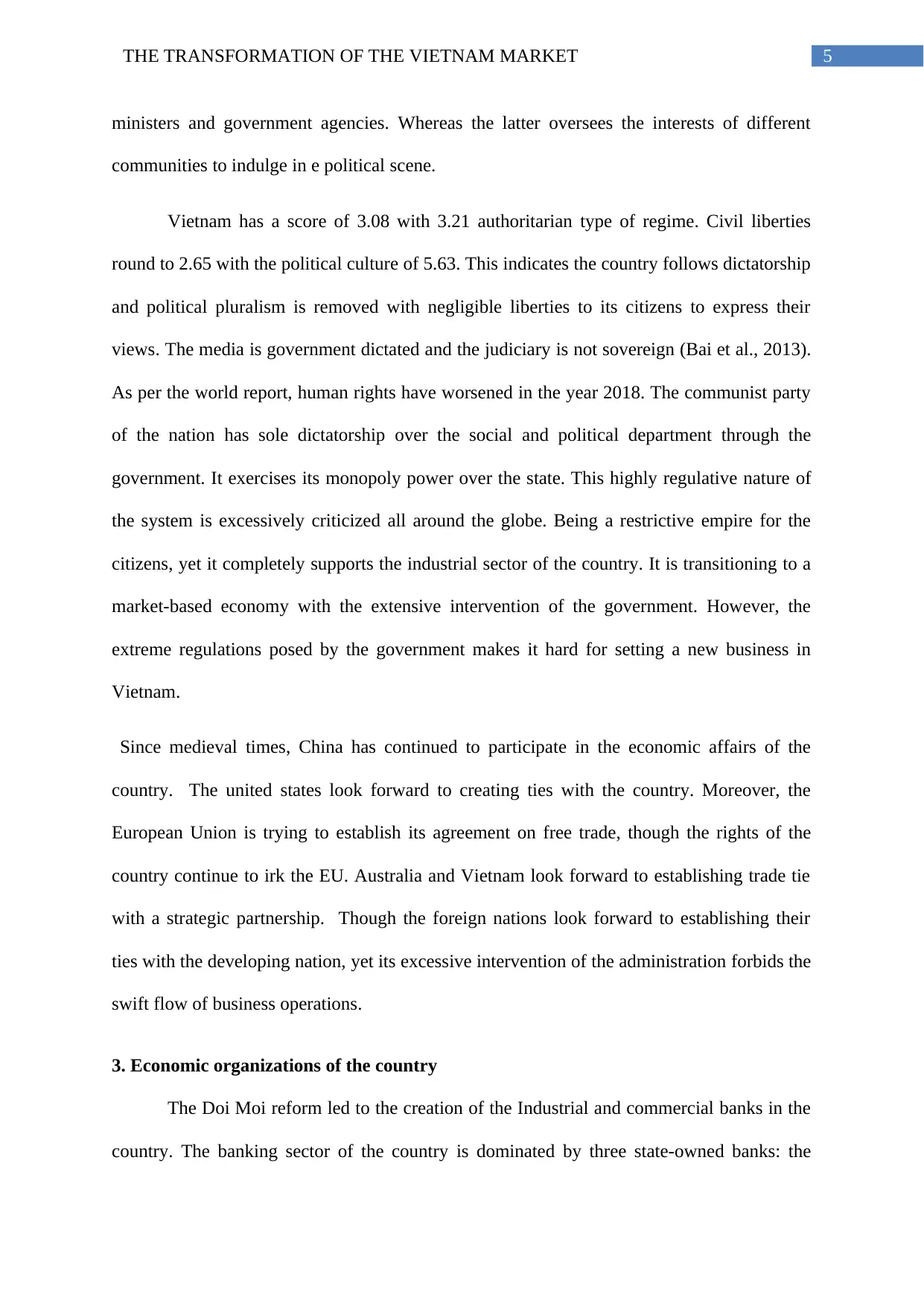
5THE TRANSFORMATION OF THE VIETNAM MARKET
ministers and government agencies. Whereas the latter oversees the interests of different
communities to indulge in e political scene.
Vietnam has a score of 3.08 with 3.21 authoritarian type of regime. Civil liberties
round to 2.65 with the political culture of 5.63. This indicates the country follows dictatorship
and political pluralism is removed with negligible liberties to its citizens to express their
views. The media is government dictated and the judiciary is not sovereign (Bai et al., 2013).
As per the world report, human rights have worsened in the year 2018. The communist party
of the nation has sole dictatorship over the social and political department through the
government. It exercises its monopoly power over the state. This highly regulative nature of
the system is excessively criticized all around the globe. Being a restrictive empire for the
citizens, yet it completely supports the industrial sector of the country. It is transitioning to a
market-based economy with the extensive intervention of the government. However, the
extreme regulations posed by the government makes it hard for setting a new business in
Vietnam.
Since medieval times, China has continued to participate in the economic affairs of the
country. The united states look forward to creating ties with the country. Moreover, the
European Union is trying to establish its agreement on free trade, though the rights of the
country continue to irk the EU. Australia and Vietnam look forward to establishing trade tie
with a strategic partnership. Though the foreign nations look forward to establishing their
ties with the developing nation, yet its excessive intervention of the administration forbids the
swift flow of business operations.
3. Economic organizations of the country
The Doi Moi reform led to the creation of the Industrial and commercial banks in the
country. The banking sector of the country is dominated by three state-owned banks: the
ministers and government agencies. Whereas the latter oversees the interests of different
communities to indulge in e political scene.
Vietnam has a score of 3.08 with 3.21 authoritarian type of regime. Civil liberties
round to 2.65 with the political culture of 5.63. This indicates the country follows dictatorship
and political pluralism is removed with negligible liberties to its citizens to express their
views. The media is government dictated and the judiciary is not sovereign (Bai et al., 2013).
As per the world report, human rights have worsened in the year 2018. The communist party
of the nation has sole dictatorship over the social and political department through the
government. It exercises its monopoly power over the state. This highly regulative nature of
the system is excessively criticized all around the globe. Being a restrictive empire for the
citizens, yet it completely supports the industrial sector of the country. It is transitioning to a
market-based economy with the extensive intervention of the government. However, the
extreme regulations posed by the government makes it hard for setting a new business in
Vietnam.
Since medieval times, China has continued to participate in the economic affairs of the
country. The united states look forward to creating ties with the country. Moreover, the
European Union is trying to establish its agreement on free trade, though the rights of the
country continue to irk the EU. Australia and Vietnam look forward to establishing trade tie
with a strategic partnership. Though the foreign nations look forward to establishing their
ties with the developing nation, yet its excessive intervention of the administration forbids the
swift flow of business operations.
3. Economic organizations of the country
The Doi Moi reform led to the creation of the Industrial and commercial banks in the
country. The banking sector of the country is dominated by three state-owned banks: the
⊘ This is a preview!⊘
Do you want full access?
Subscribe today to unlock all pages.

Trusted by 1+ million students worldwide
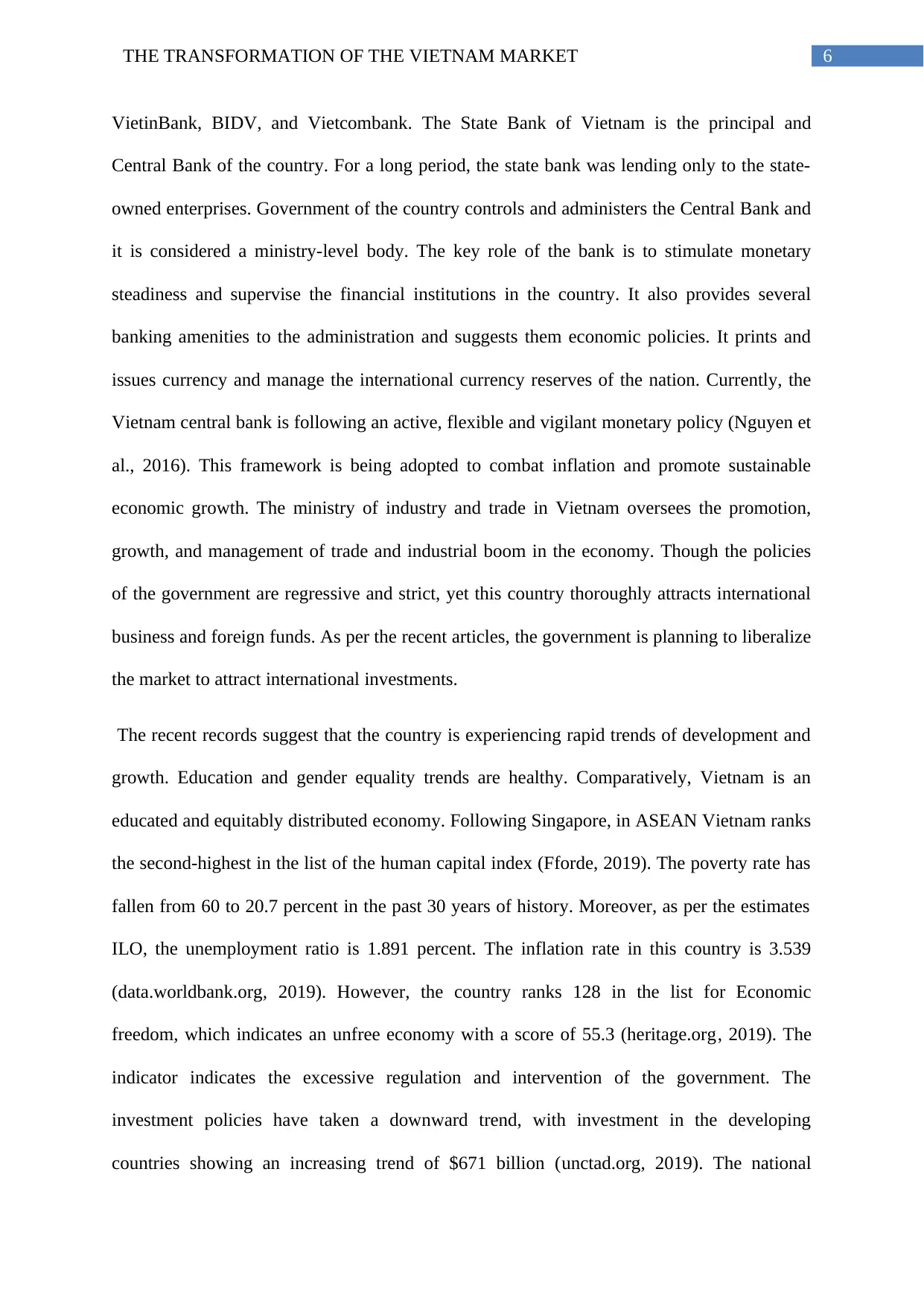
6THE TRANSFORMATION OF THE VIETNAM MARKET
VietinBank, BIDV, and Vietcombank. The State Bank of Vietnam is the principal and
Central Bank of the country. For a long period, the state bank was lending only to the state-
owned enterprises. Government of the country controls and administers the Central Bank and
it is considered a ministry-level body. The key role of the bank is to stimulate monetary
steadiness and supervise the financial institutions in the country. It also provides several
banking amenities to the administration and suggests them economic policies. It prints and
issues currency and manage the international currency reserves of the nation. Currently, the
Vietnam central bank is following an active, flexible and vigilant monetary policy (Nguyen et
al., 2016). This framework is being adopted to combat inflation and promote sustainable
economic growth. The ministry of industry and trade in Vietnam oversees the promotion,
growth, and management of trade and industrial boom in the economy. Though the policies
of the government are regressive and strict, yet this country thoroughly attracts international
business and foreign funds. As per the recent articles, the government is planning to liberalize
the market to attract international investments.
The recent records suggest that the country is experiencing rapid trends of development and
growth. Education and gender equality trends are healthy. Comparatively, Vietnam is an
educated and equitably distributed economy. Following Singapore, in ASEAN Vietnam ranks
the second-highest in the list of the human capital index (Fforde, 2019). The poverty rate has
fallen from 60 to 20.7 percent in the past 30 years of history. Moreover, as per the estimates
ILO, the unemployment ratio is 1.891 percent. The inflation rate in this country is 3.539
(data.worldbank.org, 2019). However, the country ranks 128 in the list for Economic
freedom, which indicates an unfree economy with a score of 55.3 (heritage.org, 2019). The
indicator indicates the excessive regulation and intervention of the government. The
investment policies have taken a downward trend, with investment in the developing
countries showing an increasing trend of $671 billion (unctad.org, 2019). The national
VietinBank, BIDV, and Vietcombank. The State Bank of Vietnam is the principal and
Central Bank of the country. For a long period, the state bank was lending only to the state-
owned enterprises. Government of the country controls and administers the Central Bank and
it is considered a ministry-level body. The key role of the bank is to stimulate monetary
steadiness and supervise the financial institutions in the country. It also provides several
banking amenities to the administration and suggests them economic policies. It prints and
issues currency and manage the international currency reserves of the nation. Currently, the
Vietnam central bank is following an active, flexible and vigilant monetary policy (Nguyen et
al., 2016). This framework is being adopted to combat inflation and promote sustainable
economic growth. The ministry of industry and trade in Vietnam oversees the promotion,
growth, and management of trade and industrial boom in the economy. Though the policies
of the government are regressive and strict, yet this country thoroughly attracts international
business and foreign funds. As per the recent articles, the government is planning to liberalize
the market to attract international investments.
The recent records suggest that the country is experiencing rapid trends of development and
growth. Education and gender equality trends are healthy. Comparatively, Vietnam is an
educated and equitably distributed economy. Following Singapore, in ASEAN Vietnam ranks
the second-highest in the list of the human capital index (Fforde, 2019). The poverty rate has
fallen from 60 to 20.7 percent in the past 30 years of history. Moreover, as per the estimates
ILO, the unemployment ratio is 1.891 percent. The inflation rate in this country is 3.539
(data.worldbank.org, 2019). However, the country ranks 128 in the list for Economic
freedom, which indicates an unfree economy with a score of 55.3 (heritage.org, 2019). The
indicator indicates the excessive regulation and intervention of the government. The
investment policies have taken a downward trend, with investment in the developing
countries showing an increasing trend of $671 billion (unctad.org, 2019). The national
Paraphrase This Document
Need a fresh take? Get an instant paraphrase of this document with our AI Paraphraser

7THE TRANSFORMATION OF THE VIETNAM MARKET
investment policy is aiming to promote liberalization and eliminate regulation. This implies
the changing scenario of the Vietnam government.
4. The judicial system of the country
The legal institution of the country is controlled and administered under the
constitution of the country. The current government dictates over the judiciary and the
procurators are the members of the communist party. The system comprises of the people’s
court, military tribunals, people’s procuracies, and social-political groups. The majority
decides the judgments at the people’s court. The Supreme Court is the highest organ in the
judicial body of the country supervised by the leading party. Procuracies administers the
equal distribution of law and order in the country. Current law and order of the state show the
restrictiveness for introducing a start-up business in the country. Moreover, international
treaties serve a key role in developing new law and order in the economy. The system is
trying to develop efforts to improvise the legal system of the country. This liberalization of
the law will help in attracting worldwide investments in the country. This would certainly
lead to higher productivity, growth and increase the domestic competitiveness in the
international market. Most notably the civil code of 2015, served in improving the foundation
of civil laws and business relationships in the country (Tran & Nørlund, 2015). This has been
addressed to protect human rights and protect civil interests.
Vietnam ranks 74 in the World Justice Project’s Rule of Law Index in the year 2017-
2018, with a score of 0.50 (worldjusticeproject.org, 2019). This indicates moderate adherence
of law in the economy. The country needs to open and deregulate the system to make it more
effective. Vietnam is a corrupt country with a score of 35 in International Corruption
Perception index 2017 and is placed at 107 in the world (transparency.org, 2019). This
indicates the level of corruption and the authority is not taking initiatives to end this
exploitation. The higher the level of corruption the less is the interest of international
investment policy is aiming to promote liberalization and eliminate regulation. This implies
the changing scenario of the Vietnam government.
4. The judicial system of the country
The legal institution of the country is controlled and administered under the
constitution of the country. The current government dictates over the judiciary and the
procurators are the members of the communist party. The system comprises of the people’s
court, military tribunals, people’s procuracies, and social-political groups. The majority
decides the judgments at the people’s court. The Supreme Court is the highest organ in the
judicial body of the country supervised by the leading party. Procuracies administers the
equal distribution of law and order in the country. Current law and order of the state show the
restrictiveness for introducing a start-up business in the country. Moreover, international
treaties serve a key role in developing new law and order in the economy. The system is
trying to develop efforts to improvise the legal system of the country. This liberalization of
the law will help in attracting worldwide investments in the country. This would certainly
lead to higher productivity, growth and increase the domestic competitiveness in the
international market. Most notably the civil code of 2015, served in improving the foundation
of civil laws and business relationships in the country (Tran & Nørlund, 2015). This has been
addressed to protect human rights and protect civil interests.
Vietnam ranks 74 in the World Justice Project’s Rule of Law Index in the year 2017-
2018, with a score of 0.50 (worldjusticeproject.org, 2019). This indicates moderate adherence
of law in the economy. The country needs to open and deregulate the system to make it more
effective. Vietnam is a corrupt country with a score of 35 in International Corruption
Perception index 2017 and is placed at 107 in the world (transparency.org, 2019). This
indicates the level of corruption and the authority is not taking initiatives to end this
exploitation. The higher the level of corruption the less is the interest of international
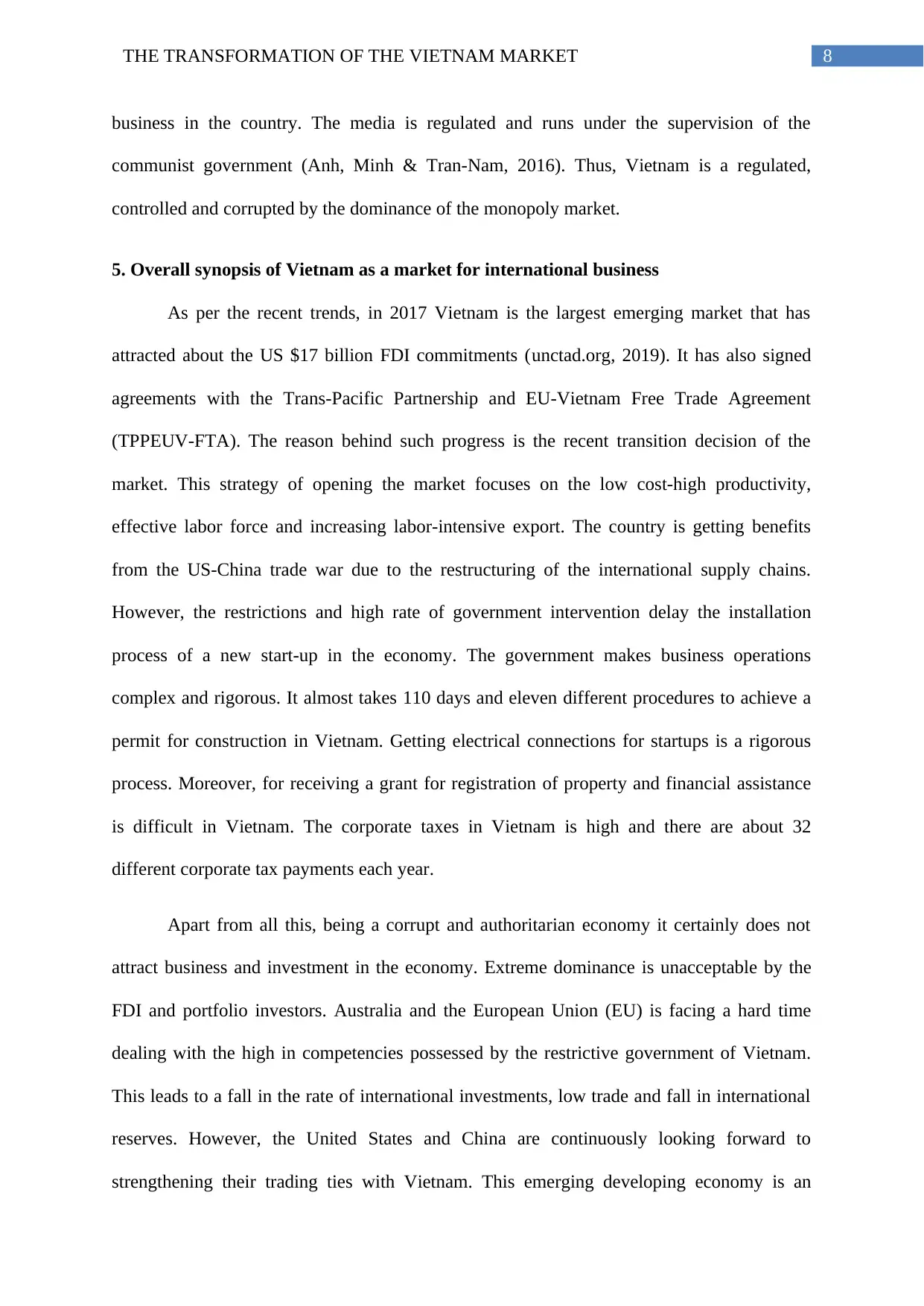
8THE TRANSFORMATION OF THE VIETNAM MARKET
business in the country. The media is regulated and runs under the supervision of the
communist government (Anh, Minh & Tran-Nam, 2016). Thus, Vietnam is a regulated,
controlled and corrupted by the dominance of the monopoly market.
5. Overall synopsis of Vietnam as a market for international business
As per the recent trends, in 2017 Vietnam is the largest emerging market that has
attracted about the US $17 billion FDI commitments (unctad.org, 2019). It has also signed
agreements with the Trans-Pacific Partnership and EU-Vietnam Free Trade Agreement
(TPPEUV-FTA). The reason behind such progress is the recent transition decision of the
market. This strategy of opening the market focuses on the low cost-high productivity,
effective labor force and increasing labor-intensive export. The country is getting benefits
from the US-China trade war due to the restructuring of the international supply chains.
However, the restrictions and high rate of government intervention delay the installation
process of a new start-up in the economy. The government makes business operations
complex and rigorous. It almost takes 110 days and eleven different procedures to achieve a
permit for construction in Vietnam. Getting electrical connections for startups is a rigorous
process. Moreover, for receiving a grant for registration of property and financial assistance
is difficult in Vietnam. The corporate taxes in Vietnam is high and there are about 32
different corporate tax payments each year.
Apart from all this, being a corrupt and authoritarian economy it certainly does not
attract business and investment in the economy. Extreme dominance is unacceptable by the
FDI and portfolio investors. Australia and the European Union (EU) is facing a hard time
dealing with the high in competencies possessed by the restrictive government of Vietnam.
This leads to a fall in the rate of international investments, low trade and fall in international
reserves. However, the United States and China are continuously looking forward to
strengthening their trading ties with Vietnam. This emerging developing economy is an
business in the country. The media is regulated and runs under the supervision of the
communist government (Anh, Minh & Tran-Nam, 2016). Thus, Vietnam is a regulated,
controlled and corrupted by the dominance of the monopoly market.
5. Overall synopsis of Vietnam as a market for international business
As per the recent trends, in 2017 Vietnam is the largest emerging market that has
attracted about the US $17 billion FDI commitments (unctad.org, 2019). It has also signed
agreements with the Trans-Pacific Partnership and EU-Vietnam Free Trade Agreement
(TPPEUV-FTA). The reason behind such progress is the recent transition decision of the
market. This strategy of opening the market focuses on the low cost-high productivity,
effective labor force and increasing labor-intensive export. The country is getting benefits
from the US-China trade war due to the restructuring of the international supply chains.
However, the restrictions and high rate of government intervention delay the installation
process of a new start-up in the economy. The government makes business operations
complex and rigorous. It almost takes 110 days and eleven different procedures to achieve a
permit for construction in Vietnam. Getting electrical connections for startups is a rigorous
process. Moreover, for receiving a grant for registration of property and financial assistance
is difficult in Vietnam. The corporate taxes in Vietnam is high and there are about 32
different corporate tax payments each year.
Apart from all this, being a corrupt and authoritarian economy it certainly does not
attract business and investment in the economy. Extreme dominance is unacceptable by the
FDI and portfolio investors. Australia and the European Union (EU) is facing a hard time
dealing with the high in competencies possessed by the restrictive government of Vietnam.
This leads to a fall in the rate of international investments, low trade and fall in international
reserves. However, the United States and China are continuously looking forward to
strengthening their trading ties with Vietnam. This emerging developing economy is an
⊘ This is a preview!⊘
Do you want full access?
Subscribe today to unlock all pages.

Trusted by 1+ million students worldwide
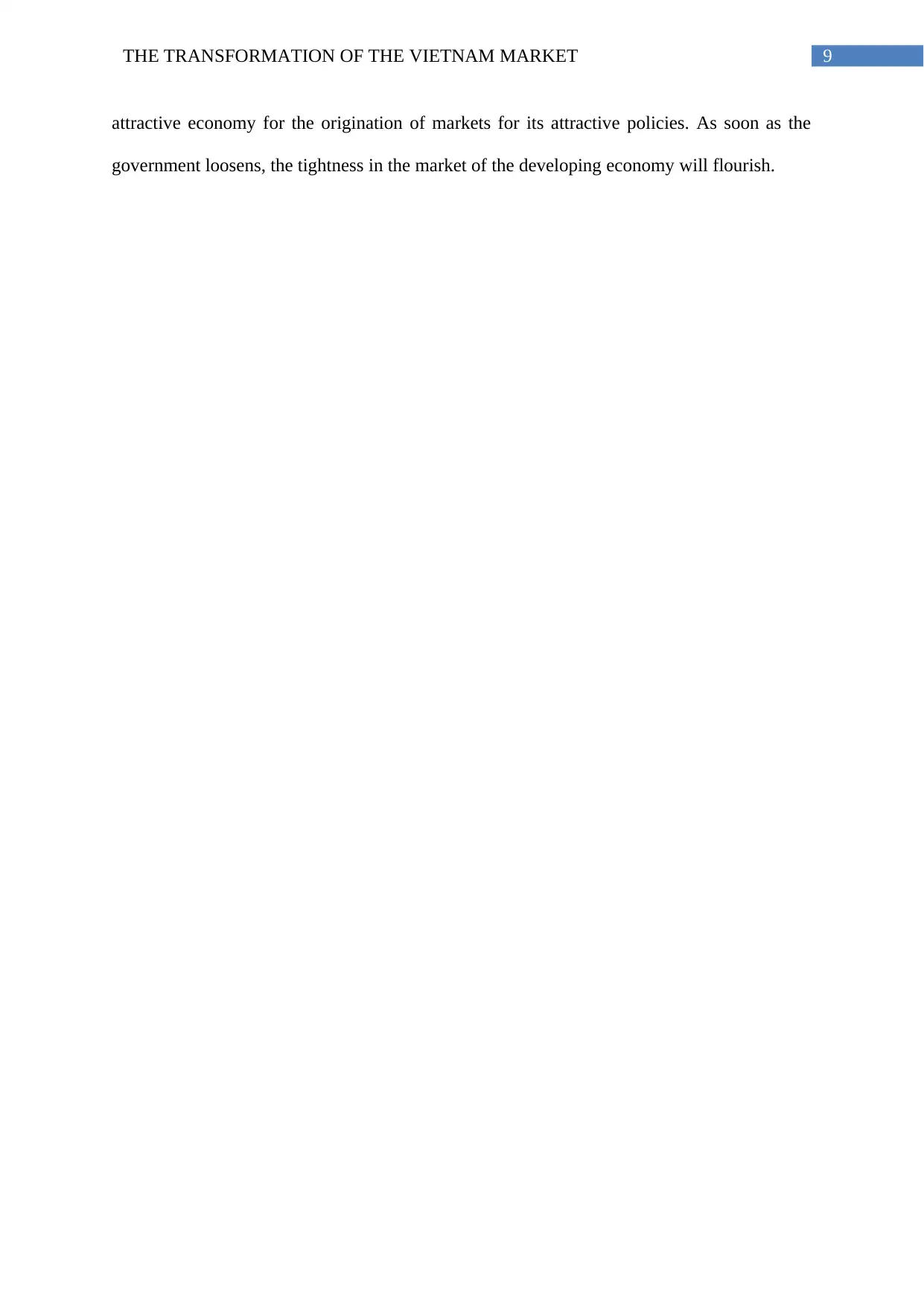
9THE TRANSFORMATION OF THE VIETNAM MARKET
attractive economy for the origination of markets for its attractive policies. As soon as the
government loosens, the tightness in the market of the developing economy will flourish.
attractive economy for the origination of markets for its attractive policies. As soon as the
government loosens, the tightness in the market of the developing economy will flourish.
Paraphrase This Document
Need a fresh take? Get an instant paraphrase of this document with our AI Paraphraser
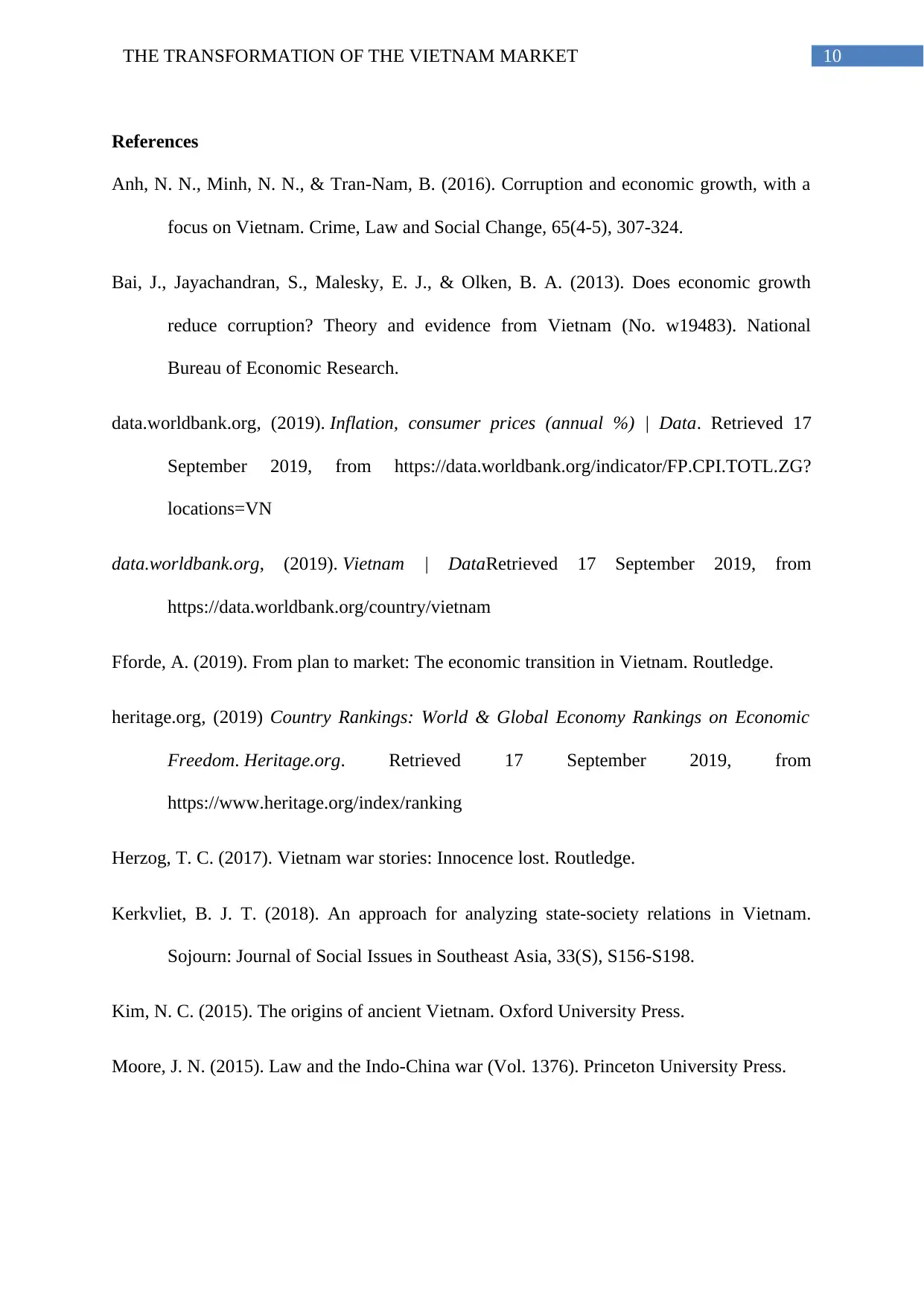
10THE TRANSFORMATION OF THE VIETNAM MARKET
References
Anh, N. N., Minh, N. N., & Tran-Nam, B. (2016). Corruption and economic growth, with a
focus on Vietnam. Crime, Law and Social Change, 65(4-5), 307-324.
Bai, J., Jayachandran, S., Malesky, E. J., & Olken, B. A. (2013). Does economic growth
reduce corruption? Theory and evidence from Vietnam (No. w19483). National
Bureau of Economic Research.
data.worldbank.org, (2019). Inflation, consumer prices (annual %) | Data. Retrieved 17
September 2019, from https://data.worldbank.org/indicator/FP.CPI.TOTL.ZG?
locations=VN
data.worldbank.org, (2019). Vietnam | DataRetrieved 17 September 2019, from
https://data.worldbank.org/country/vietnam
Fforde, A. (2019). From plan to market: The economic transition in Vietnam. Routledge.
heritage.org, (2019) Country Rankings: World & Global Economy Rankings on Economic
Freedom. Heritage.org. Retrieved 17 September 2019, from
https://www.heritage.org/index/ranking
Herzog, T. C. (2017). Vietnam war stories: Innocence lost. Routledge.
Kerkvliet, B. J. T. (2018). An approach for analyzing state-society relations in Vietnam.
Sojourn: Journal of Social Issues in Southeast Asia, 33(S), S156-S198.
Kim, N. C. (2015). The origins of ancient Vietnam. Oxford University Press.
Moore, J. N. (2015). Law and the Indo-China war (Vol. 1376). Princeton University Press.
References
Anh, N. N., Minh, N. N., & Tran-Nam, B. (2016). Corruption and economic growth, with a
focus on Vietnam. Crime, Law and Social Change, 65(4-5), 307-324.
Bai, J., Jayachandran, S., Malesky, E. J., & Olken, B. A. (2013). Does economic growth
reduce corruption? Theory and evidence from Vietnam (No. w19483). National
Bureau of Economic Research.
data.worldbank.org, (2019). Inflation, consumer prices (annual %) | Data. Retrieved 17
September 2019, from https://data.worldbank.org/indicator/FP.CPI.TOTL.ZG?
locations=VN
data.worldbank.org, (2019). Vietnam | DataRetrieved 17 September 2019, from
https://data.worldbank.org/country/vietnam
Fforde, A. (2019). From plan to market: The economic transition in Vietnam. Routledge.
heritage.org, (2019) Country Rankings: World & Global Economy Rankings on Economic
Freedom. Heritage.org. Retrieved 17 September 2019, from
https://www.heritage.org/index/ranking
Herzog, T. C. (2017). Vietnam war stories: Innocence lost. Routledge.
Kerkvliet, B. J. T. (2018). An approach for analyzing state-society relations in Vietnam.
Sojourn: Journal of Social Issues in Southeast Asia, 33(S), S156-S198.
Kim, N. C. (2015). The origins of ancient Vietnam. Oxford University Press.
Moore, J. N. (2015). Law and the Indo-China war (Vol. 1376). Princeton University Press.
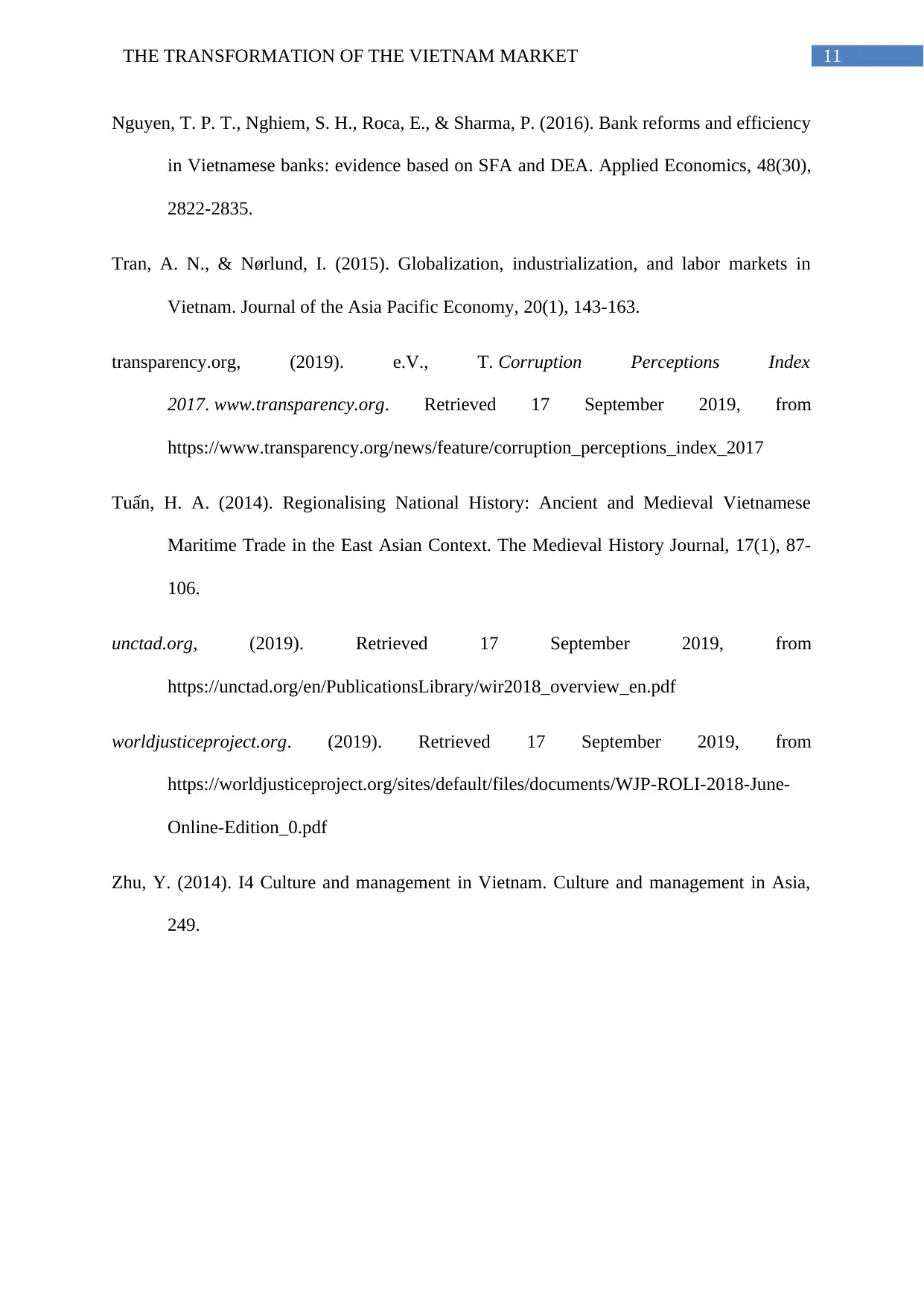
11THE TRANSFORMATION OF THE VIETNAM MARKET
Nguyen, T. P. T., Nghiem, S. H., Roca, E., & Sharma, P. (2016). Bank reforms and efficiency
in Vietnamese banks: evidence based on SFA and DEA. Applied Economics, 48(30),
2822-2835.
Tran, A. N., & Nørlund, I. (2015). Globalization, industrialization, and labor markets in
Vietnam. Journal of the Asia Pacific Economy, 20(1), 143-163.
transparency.org, (2019). e.V., T. Corruption Perceptions Index
2017. www.transparency.org. Retrieved 17 September 2019, from
https://www.transparency.org/news/feature/corruption_perceptions_index_2017
Tuấn, H. A. (2014). Regionalising National History: Ancient and Medieval Vietnamese
Maritime Trade in the East Asian Context. The Medieval History Journal, 17(1), 87-
106.
unctad.org, (2019). Retrieved 17 September 2019, from
https://unctad.org/en/PublicationsLibrary/wir2018_overview_en.pdf
worldjusticeproject.org. (2019). Retrieved 17 September 2019, from
https://worldjusticeproject.org/sites/default/files/documents/WJP-ROLI-2018-June-
Online-Edition_0.pdf
Zhu, Y. (2014). I4 Culture and management in Vietnam. Culture and management in Asia,
249.
Nguyen, T. P. T., Nghiem, S. H., Roca, E., & Sharma, P. (2016). Bank reforms and efficiency
in Vietnamese banks: evidence based on SFA and DEA. Applied Economics, 48(30),
2822-2835.
Tran, A. N., & Nørlund, I. (2015). Globalization, industrialization, and labor markets in
Vietnam. Journal of the Asia Pacific Economy, 20(1), 143-163.
transparency.org, (2019). e.V., T. Corruption Perceptions Index
2017. www.transparency.org. Retrieved 17 September 2019, from
https://www.transparency.org/news/feature/corruption_perceptions_index_2017
Tuấn, H. A. (2014). Regionalising National History: Ancient and Medieval Vietnamese
Maritime Trade in the East Asian Context. The Medieval History Journal, 17(1), 87-
106.
unctad.org, (2019). Retrieved 17 September 2019, from
https://unctad.org/en/PublicationsLibrary/wir2018_overview_en.pdf
worldjusticeproject.org. (2019). Retrieved 17 September 2019, from
https://worldjusticeproject.org/sites/default/files/documents/WJP-ROLI-2018-June-
Online-Edition_0.pdf
Zhu, Y. (2014). I4 Culture and management in Vietnam. Culture and management in Asia,
249.
⊘ This is a preview!⊘
Do you want full access?
Subscribe today to unlock all pages.

Trusted by 1+ million students worldwide
1 out of 12
Your All-in-One AI-Powered Toolkit for Academic Success.
+13062052269
info@desklib.com
Available 24*7 on WhatsApp / Email
![[object Object]](/_next/static/media/star-bottom.7253800d.svg)
Unlock your academic potential
Copyright © 2020–2025 A2Z Services. All Rights Reserved. Developed and managed by ZUCOL.
